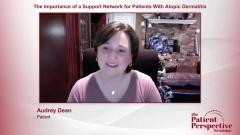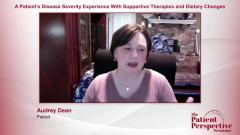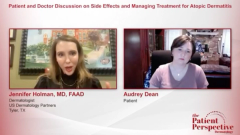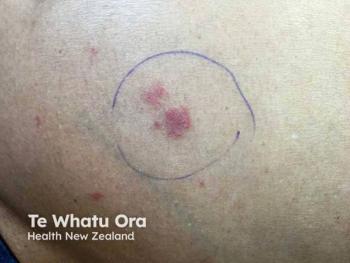
The Pathophysiology and Major Comorbidities in Atopic Dermatitis
A dermatologist and her patient discuss the pathophysiology and major comorbidities of atopic dermatitis (AD), highlighting the main differences between adult and adolescent AD.
Episodes in this series

Transcript
Jennifer Holman, MD, FAAD: Hello, and thank you for joining this Dermatology Times Patient Journey program, titled “The Atopic Dermatitis Patient Journey From Diagnosis to Management.” I’m your host, Dr Jennifer Holman. I’m a board-certified dermatologist and dermatologic micrographic surgeon. I practice in Tyler, Texas, with US Dermatology Partners, and I’ve been here in private practice for just over 15 years. I’m honored to be joined today by Audrey Dean, who’s been one of my patients. She’s seen a few physicians in our office, and I [started treating] Audrey…[about] a year and a half ago…. Thank you so much for joining us today. Let’s begin. First, we’re going to talk about atopic dermatitis [AD] and how it impacts [a] patient’s quality of life. I think the conversation around [AD] has become more and more prevalent. It’s kind of like we conquered psoriasis and we’ve moved into the frontier of [AD]. Why don’t we start [with the pathophysiology of AD]? [With AD], there’s a genetic predisposition. We see some association with other allergic or autoimmune conditions as well, but there’s a key component of epidermal barrier dysfunction, and that atopic march can begin when we have this disruption in the skin barrier. It’s almost like this vicious cycle. You become sensitized to other things in your environment, and it’s almost like that component can continue to worsen with time once that epidermal barrier dysfunction begins. There’s also dysregulation of the immune system, and you see a lot of our newer therapies targeting those specific immune mediators that are dysregulated in [AD]. There’s quite a few comorbidities that are associated with [AD], as well. The ones that we think of off the top of our heads [include] allergic processes, allergic asthma, seasonal allergies, [and] skin infections. But there’s also other associated comorbidities that we know as we study more about [AD]. There’s quite a few autoimmune diseases that are associated with [AD], and Audrey can speak to some of those things. But alopecia areata is one of them, [and] we see chronic urticaria associated with that as well. We’re starting to see the cardiovascular associations, and mental health is a big one that is its own entity and caused by some of the quality-of-life impacts with [AD]. Sleep dysregulation is a huge problem in [AD], typically related to the severity of itch these patients experience. There’s some lower correlation with some metabolic diseases as well, but there’s a lot of things as we learn more and more. [What is] very interesting is the mental health aspect [and] how much this impacts a patient’s quality of life. Audrey [has] more—and you can tell your story better than I can—of this adult presentation of [AD]. As we were treating other things that were going on with your immune system in your skin, this continued to present itself as something that was more and more predominant…. We know the difference between the classic childhood presentation of [AD] and the adult presentation of [AD]. These kids are pretty used to diagnosing—their risk, they’re flexural areas, they’re very involved. You see it pop up typically within the first few years of life. Those kids will [often] grow out of it, [but] certainly not all of them do. [With] adult [AD], we see less of that flexural involvement [but] a lot more head and neck involvement, which was the case with Audrey. You also compounded all those sensitizations over time, [and] it can continue to get worse and worse the more that you become sensitized to your environment. That nummular form of [AD] are those cone-shaped lesions. That’s something that I typically don’t see in the childhood presentation of [AD]. But as we talk through this, Audrey, I’ll let you speak to your story and what some of your initial symptoms were with your skin disease.
Transcript is AI-generated and edited for clarity and readability.
Newsletter
Like what you’re reading? Subscribe to Dermatology Times for weekly updates on therapies, innovations, and real-world practice tips.




























